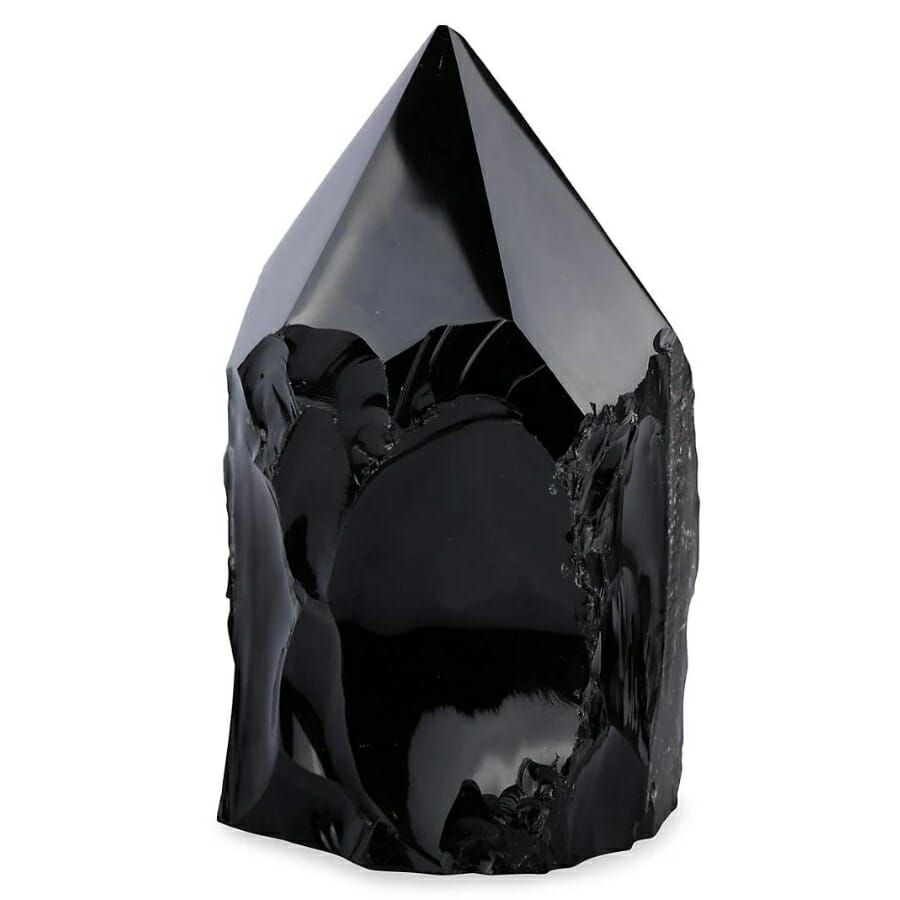Onyx and obsidian are different and interesting natural materials that have held people’s attention for hundreds of years because of their unique qualities. At first glance, these two look like they are from different planets.
Even though obsidian and onyx differ in looks, origin, and properties, they are both made of the same base and have been used for both practical and aesthetic purposes for a long time.
Both specimens have been valued for their beauty and used to make jewelry, art, and other decorative items across cultures and time.
In this article, we’ll look at what sets these two apart and what they have in common. We’ll look at their different characteristics and compare and contrast their qualities.
Obsidian vs. Onyx – The Major Differences
We’ll first talk about what makes them different from one another. They have many things in common, but these are the main things to look for to tell them apart.
Appearance – Obsidian looks more like glass
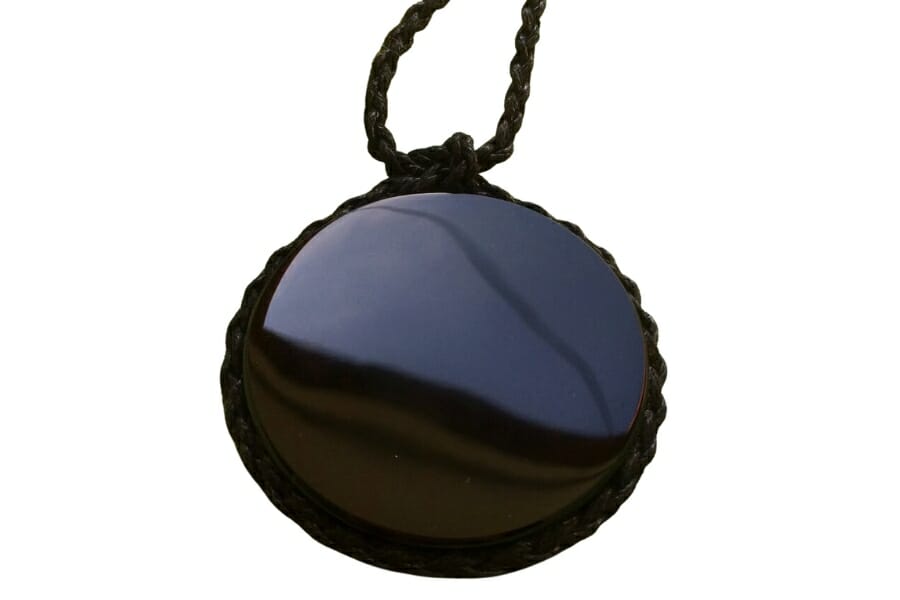
Obsidian and onyx are both natural minerals, but they look very different from each other. This makes them interesting to look at.
Obsidian is made when lava cools quickly and hardens. It has a smooth, shiny surface that looks like dark glass. Its main color is usually black, but due to impurities, it can also be brown, green, red, or even have rare iridescent colors.
Obsidian doesn’t have visible crystal patterns because it has no crystalline structure. This gives it a smooth, shiny surface that has been used for tools, weapons, and decorations throughout history.
On the other hand, onyx, a type of chalcedony with parallel bands of different colors, looks very interesting. The most common kind has black and white bands but can also have bars in various shades of brown or other colors.
Onyx is often used for jewelry and other decorative pieces because its bands make an interesting pattern. This beautiful stone has a unique banding effect from how its microcrystalline structure is created.
Obsidian is fascinating because it looks like glass and has a smooth, shiny surface, while onyx is attractive because it has a beautiful banding pattern.
Color – Onyx is mostly black and white
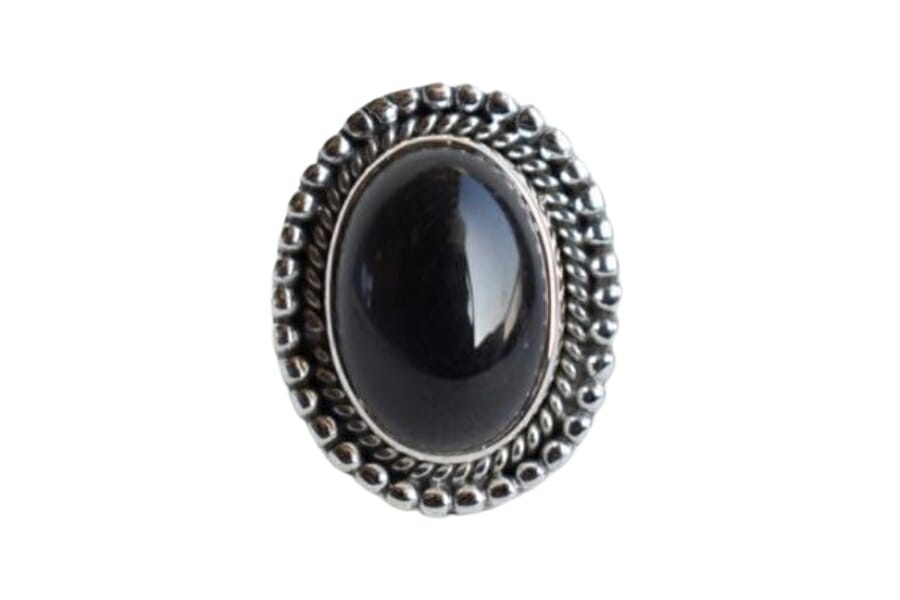
Onyx and obsidian are easily distinguished from each other because their colors are very different. Obsidian usually comes in dark colors, most often black. Due to impurities, it can also be brown, green, red, and even sometimes iridescent.
The deep black type of obsidian is known for its smooth and shiny appearance, while the most common onyx has alternate black and white bands. This creates a striking contrast that draws the eye.
Onyx can have bands of shades of brown and other colors besides classic black and white. This gives it a wide range of appealing looks for different uses.
Due to impurities, obsidian can be black or other colors. Onyx has a mesmerizing banded pattern that makes it stand out. Both stones are valued for their unique and visually appealing looks.
Crystal structure – Obsidian has no crystalline structure
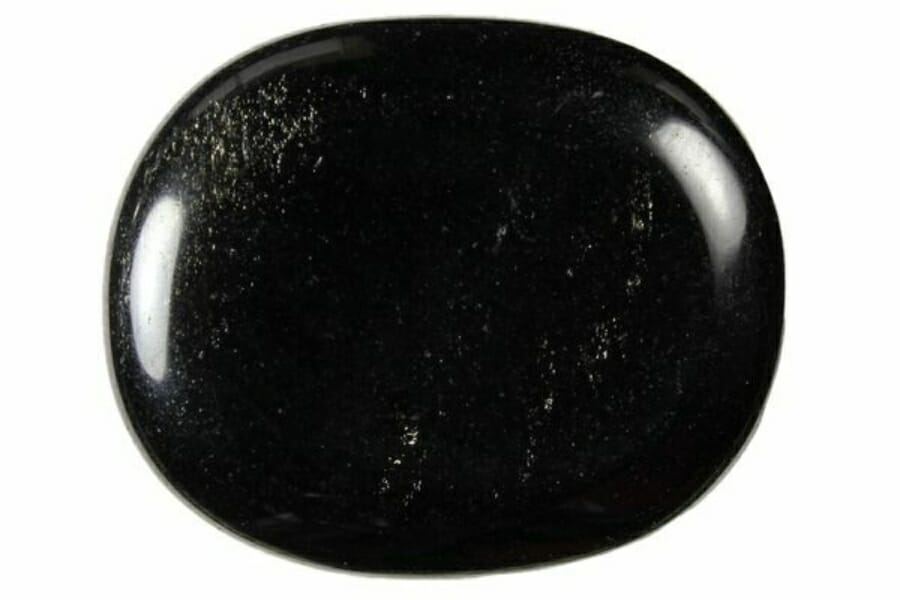
Obsidian has an amorphous, non-crystalline structure because it cools too rapidly for crystals to form. It’s a kind of volcanic glass, and it has no clear crystal structure altogether.
Because of this, obsidian was valuable in ancient times for making tools and weapons.
Onyx possesses a microcrystalline structure, which is characteristic of chalcedony minerals. These tiny crystals look amazing because they line up in parallel bands of different colors.
Even though the bands are often black and white, onyx can also have brown and other colors, which add to its beauty.
Obsidian’s lack of crystal structure results in its smooth and glassy texture. Onyx has tiny crystals arranged in a way that makes its bands stand out.
Formation – Onyx forms in igneous rocks
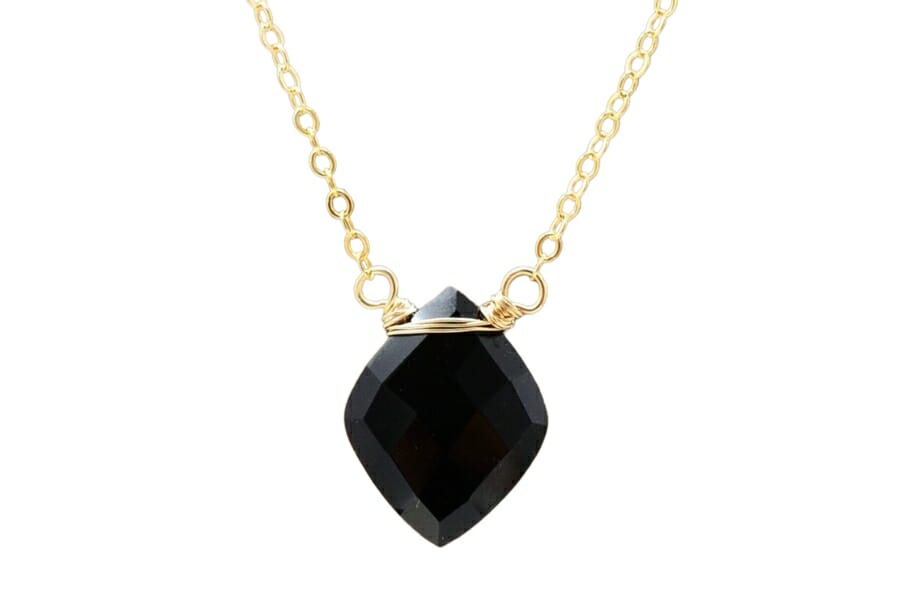
The formation processes of obsidian and onyx lead to their unique origins and characteristics.
Obsidian is formed when lava cools quickly above the surface of the Earth, like when a volcano erupts. When hot lava comes into contact with cooler air or water, it cools quickly. This gives obsidian a glassy texture.
Onyx usually forms in the spaces between igneous rocks, where mineral-rich water deposits layers of chalcedony over time, giving it a banded look. It’s a type of silica that is not crystallized and has tiny grains.
The alternating bands of different colors in onyx are created by variations in the mineral content during this slow process.
Fluorescence – Obsidian does not glow in the dark
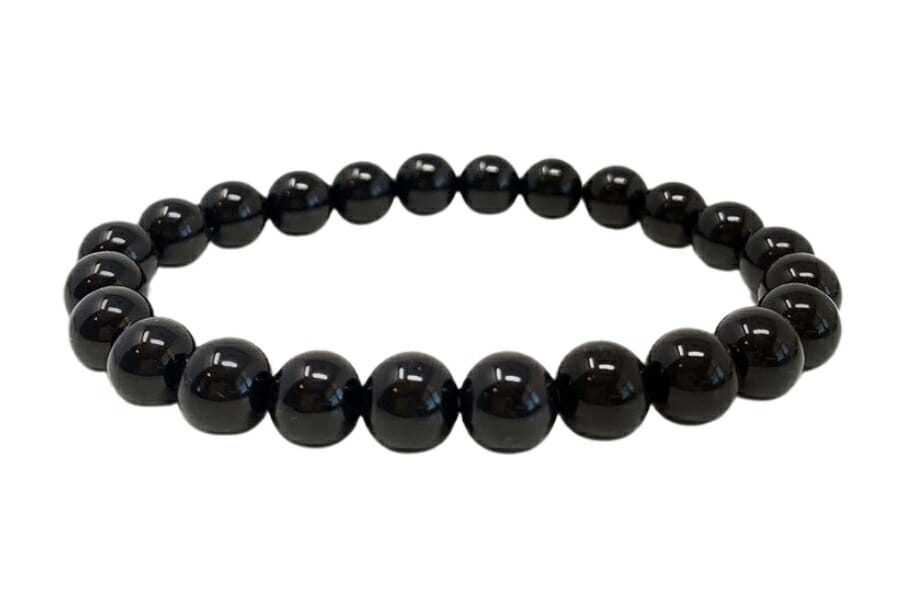
Fluorescence is a fantastic thing about some minerals and rocks. It’s a unique and fascinating property that lets them show off their beautiful features.
It means they give off visible light when exposed to ultraviolet (UV) light. Under UV light, these materials soak up the energy and then send it back out as visible light, making a glow that can change in color and intensity.
The beautiful glow of some materials under ultraviolet (UV) light shows that both obsidian and onyx have their qualities.
Obsidian, the sleek and mysterious volcanic glass tends to be a bit of a wallflower. Most of the time, the UV party lights don’t bother it, and it doesn’t glow much.
Obsidian doesn’t glow in the dark, but its striking color and smooth texture make it a rock star in its own right.
Onyx, however, could be a real eye-catcher under UV light. Some kinds of onyx can glow in bright colors like green, yellow, orange, and even beautiful red. Fluorescence is caused by trace elements or impurities in the stone that react with UV light to make the stone glow.
Obsidian might not be an excellent fluorescent performer, but onyx steals the show with its mesmerizing glow, making it a stunning show under UV light.
Hardness – Onyx has a higher hardness
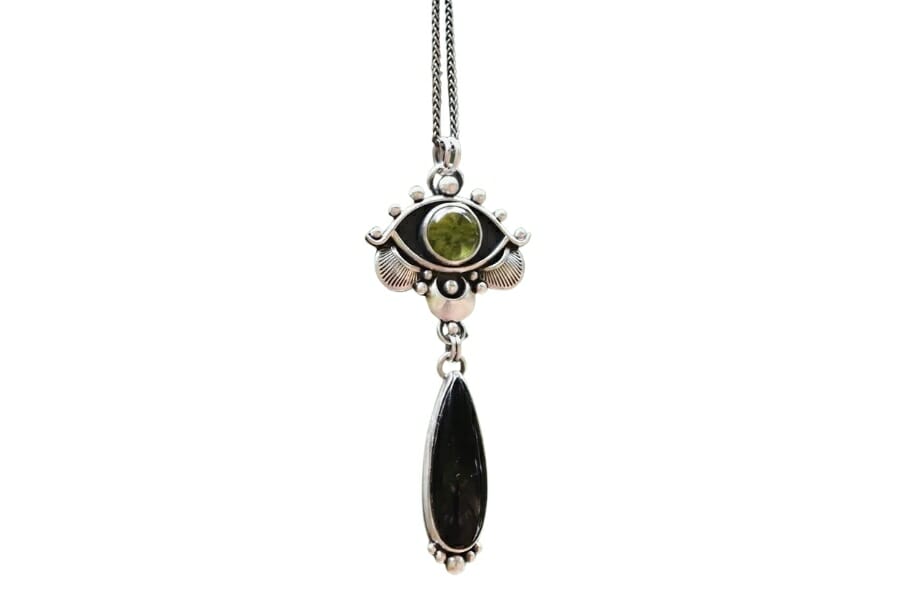
Hardness is one of the most essential things about minerals and rocks. It means how resistant they are to being scratched or dented.
On the Mohs scale, it goes from 1 (very soft) to 10 (very hard). Knowing how hard different rocks are helps us identify and use them for various practical purposes.
Obsidian, the volcanic glass with a smooth and glassy appearance has a hardness of around 5 to 5.5 on the Mohs scale. This means more complex materials, like steel or quartz, can scratch obsidian.
It’s not as hard as some other stones, but it has been used for cutting tools and weapons for a long time because it breaks into sharp pieces and can be used to make sharp edges.
On the Mohs scale, onyx is usually harder than obsidian, ranging from 6.5 to 7. This makes Onyx more wear-resistant and less likely that everyday materials will scratch it.
Its high hardness makes it durable and suitable for carving intricate designs into jewelry and other decorative items.
Obsidian and onyx are used differently because of their hardness. Obsidian isn’t too hard, so it can be shaped into useful tools. Onyx, on the other hand, is very hard, so it’s durable and often used as a decorative stone.
Luster – Obsidian is non-metallic
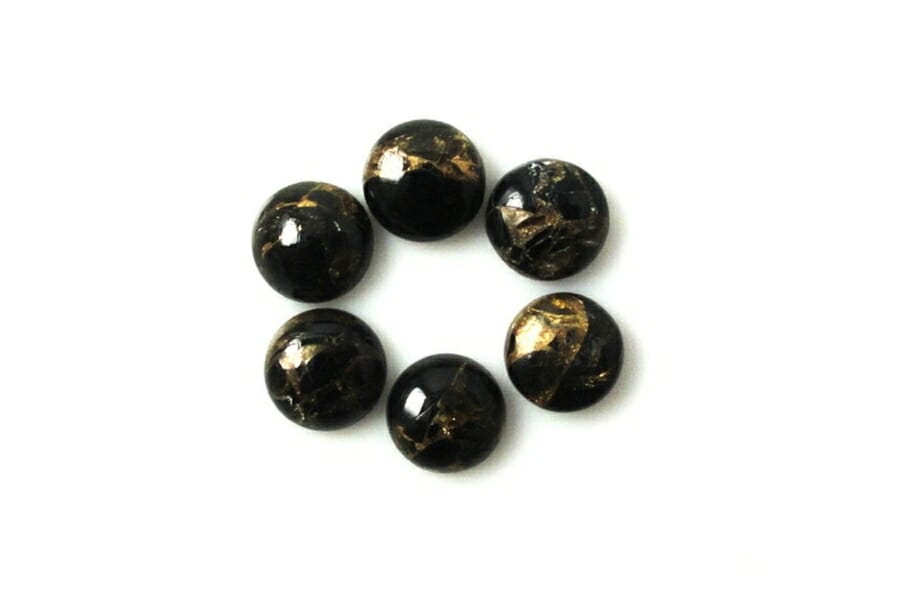
Luster is a fascinating characteristic of minerals and rocks that describes how they reflect light. It gives us insights into their surface appearance and texture, making them shiny or dull.
The two main types of luster are metallic and non-metallic, which help distinguish different rocks and minerals.
Obsidian usually doesn’t have a metallic shine because its surface is smooth and glassy. It looks like glass because it’s shiny and reflects light. Its non-crystalline structure lets light bounce off its surface evenly, giving it a polished, glassy look.
Obsidian is always liked for its shine and typically displays a vitreous luster.
The luster of onyx can be described as waxy or silky, giving it a softer and smoother appearance compared to the glossy sheen of obsidian. The silky shine comes from the way chalcedony is made up of tiny crystals.
The bands in onyx and its soft shine make it a beautiful gemstone and decorative material.
Streak – Onyx leaves a white streak when scratched on a surface
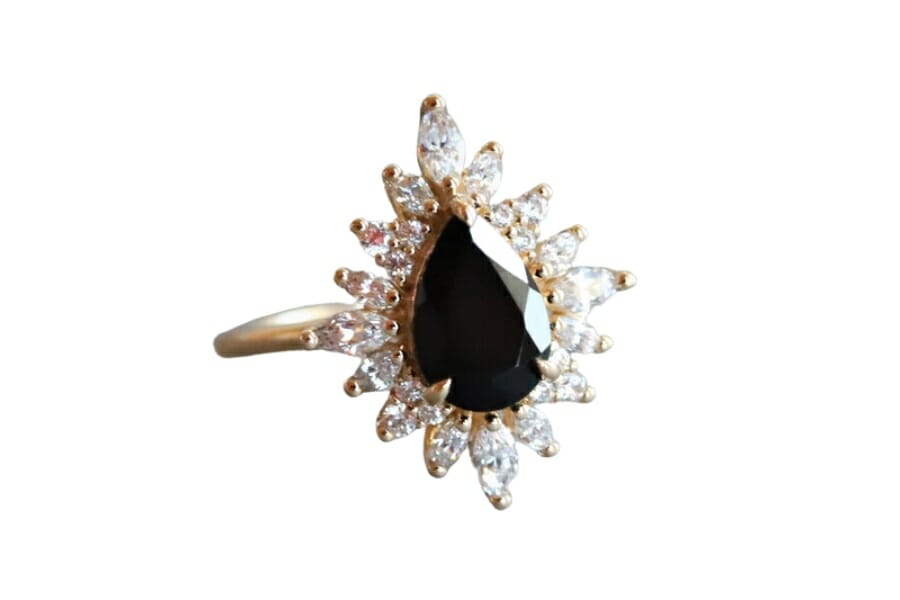
Streak is a fantastic property of minerals that refers to the color of their powdered form. It’s like finding a secret hidden beneath the surface. To test the streak, we rub the mineral against a porcelain plate to see what powder color it leaves behind.
Since obsidian is a rock and not a mineral, it doesn’t produce any colored powder when rubbed against a plate. It keeps its secrets well hidden, leaving us to admire its striking appearance on the surface.
Onyx does have a streak, which is usually white. When we scratch onyx with a porcelain plate, it leaves behind a white powder that stands out against the different colors in its bands.
This white streak helps you tell onyx apart from other minerals with different colored streaks.
Location – Obsidians are found near volcanoes
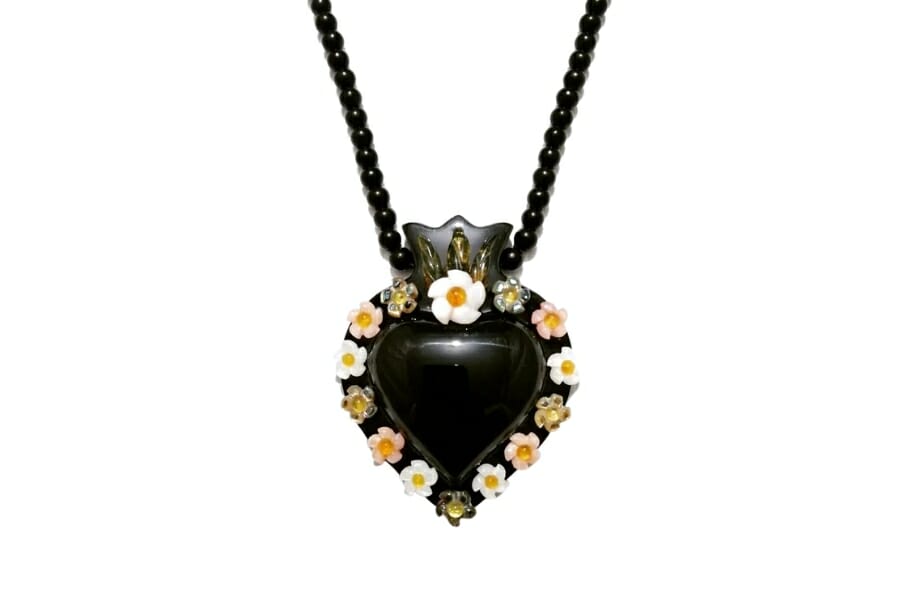
The locations where we can find these rocks can give us clues about how they formed geologically. Although rockhounding is a more general activity, you can also check out these best rockhounding locations for obsidians and onyx.
Obsidian comes from volcanoes, so it can be found in many places around the world where volcanoes have erupted in the past or more recently. It’s found in large amounts in places like the United States, Mexico, Iceland, and Italy.
Onyx is usually found in different geological settings compared to obsidian. It’s commonly associated with limestone caves and other environments where mineral-rich water can deposit layers of chalcedony.
Countries like Brazil, India, and Mexico are well-known for their sources of onyx. The formation of onyx in these underground spaces allows for the development of its striking banded appearance.
For more chances of finding onyx or obsidian, check our guide on how to find crystals near you.
Price – Onyx can be more expensive
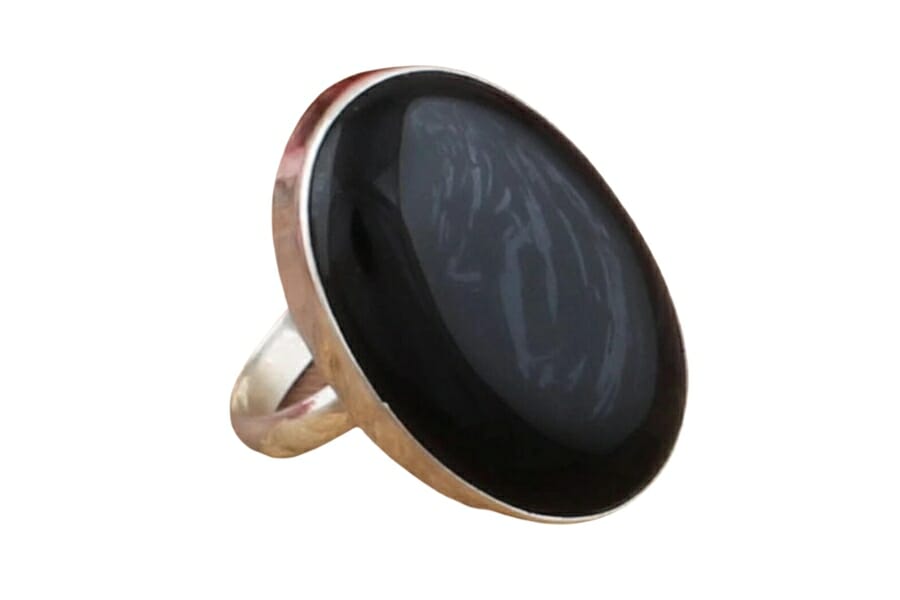
Obsidian and onyx’s prices reflect how valuable they are on the market and are influenced by factors such as rarity, demand, quality, and size.
Compared to onyx, obsidians are cheaper. The price of obsidian depends on its color, size, and any patterns or other features that make it special.
But because obsidian is not very rare and easy to find, it’s often considered a cost-effective material for making jewelry, decorative items, and even the raw materials for some tools.
Most of the time, onyx costs more than obsidian. The colors of the bands, especially the black and white combination, make it more valuable. The price of onyx is also affected by how well the bars are made, the clarity, and their size.
Onyx is very popular because it can be used to make fine jewelry, carvings, and other high-end decorative items. Because of this, onyx is in higher demand and costs more than obsidian.
Check out our guides on the more specific pricing information of how much obsidian is worth and the value of onyx.
Onyx vs. Obsidian – The Similarities
Now that we’ve discussed how onyx and obsidian are different, we’ll discuss how they’re the same. Most of the time, these characteristics are similar to obsidian and onyx.
Chemical composition – Both obsidian and onyx are made of silicon dioxide
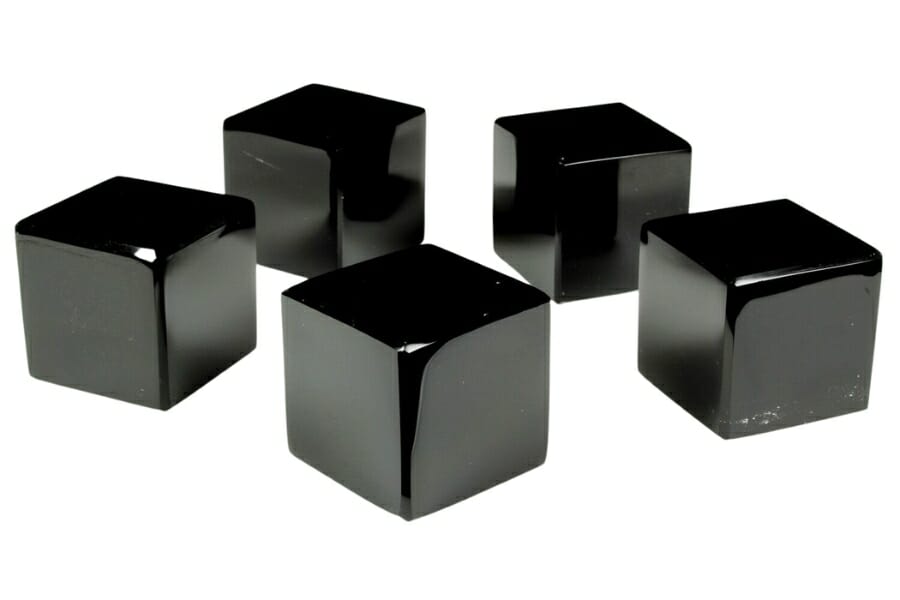
The chemical composition of minerals and rocks is like their secret recipe, it determines their unique properties and characteristics.
Both obsidian and onyx are mostly made of silicon dioxide, which is also the main ingredient in obsidian (SiO2). This means that both rocks are made of the same chemical elements and their basic building blocks are similar.
As a type of volcanic glass, obsidian is mostly silicon dioxide. But depending on where it was made and what other things were around at the time, obsidian may have small amounts of other things like iron and magnesium oxides, which can make it brown, green, or red. The different colors in obsidian come from these things that aren’t pure.
In the same way, onyx is mostly made of silicon dioxide. But it has a banded look because layers of different colors alternate. This is because the mineral content of the rock changed as it was being made.
Both obsidian and onyx are mostly made of silicon dioxide, which gives them similar basic properties. Obsidian is mostly a glassy rock with different colors caused by impurities. Onyx has a chalcedonic structure that look like it has bands.
Cleavage – Neither onyx nor obsidian have cleavage
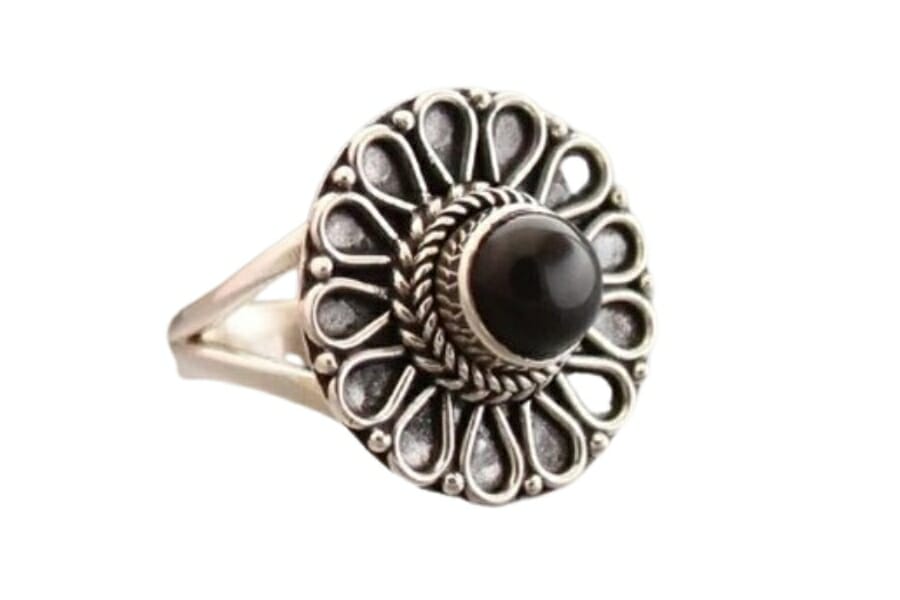
Cleavage is a very important property that describes how a mineral breaks into pieces with smooth planes. But obsidian and onyx are both the same in this way: they don’t have much or any cleavage.
Obsidian and onyx don’t break along smooth planes like minerals that have perfect cleavage. Instead, they break in different ways, making rough and jagged surfaces.
The atoms inside obsidian are not arranged in a way that would cause it to break. When obsidian is stressed, it breaks in a way that looks like a shell. This is called a conchoidal fracture.
This kind of break gives obsidian its characteristic sharp edges, which ancient people used to make tools and weapons with cutting edges.
Onyx doesn’t have a clear split either. Instead, when onyx breaks, it creates uneven surfaces and edges. This pattern of cracks is typical of chalcedony minerals and makes onyx strong.
Conductivity – Obsidian and onyx both don’t conduct heat
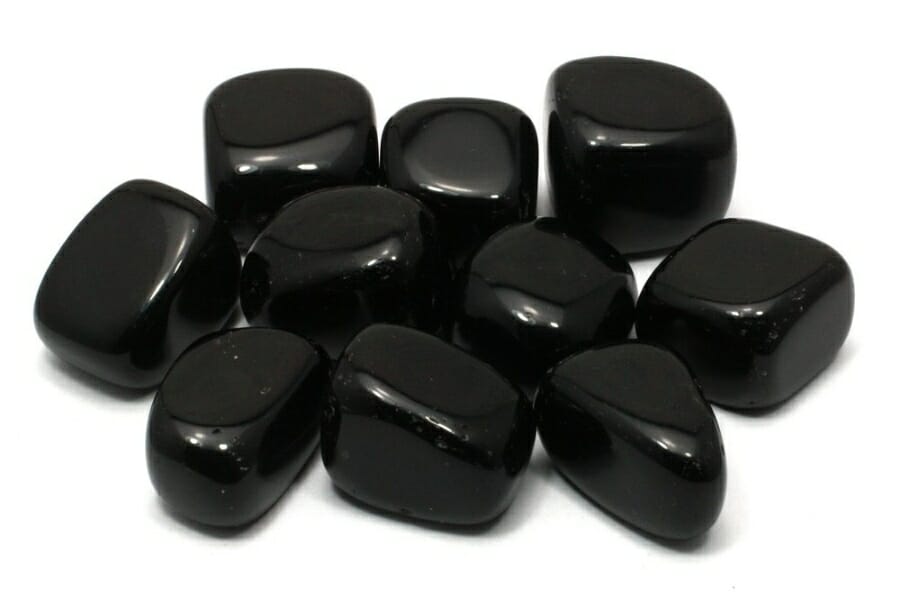
Conductivity is an interesting property that relates to the material’s ability to conduct electricity or heat. Both obsidian and onyx share a similarity in this aspect – they are both poor conductors of both electricity and heat.
Obsidian is a non-metallic volcanic glass, so it has no metallic elements that would help electrons move, which is needed for electricity to flow. Because of this, obsidian is an insulator that doesn’t allow the flow of electricity current.
Onyx is a non-metallic mineral with no metallic parts that would allow it to conduct electricity. Like obsidian, it keeps electricity from going through it. Also, the microcrystalline structure of onyx, like the amorphous structure of obsidian, makes it a poor conductor of heat.
Density – Onyx and obsidian have relatively similar densities
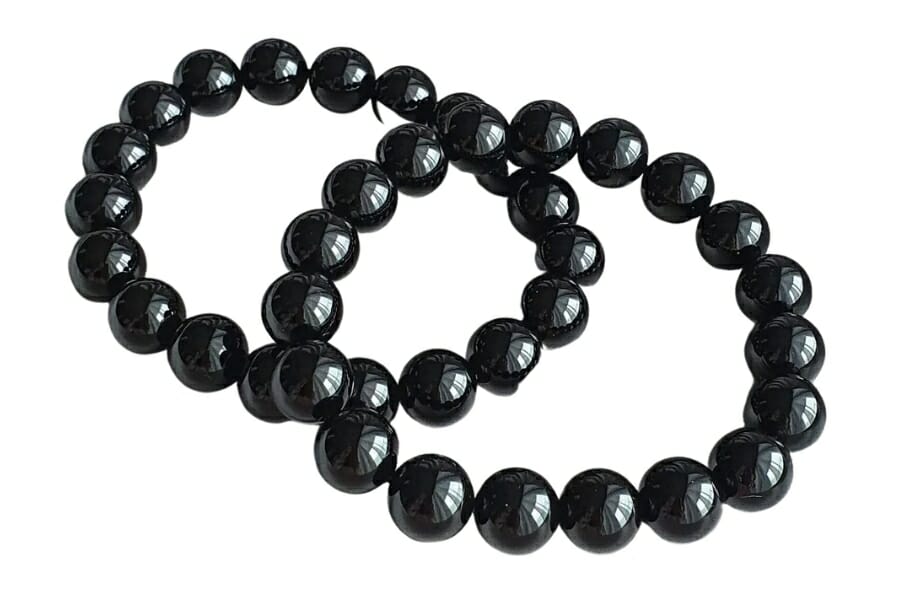
Density is an interesting property that shows a material’s mass in a certain volume. Obsidian and onyx have about the same density, so they have something in common.
Obsidian’s density is usually between 2.4 and 2.6 grams per cubic centimeter (g/cm3). This rock or mineral is light because it is low density compared to many other rocks and minerals.
Even though obsidian has a low density, it’s still a solid and durable material that can be used for tools, weapons, and artistic creations.
Onyx is slightly denser than obsidian but are relatively the same. It ranges from 2.6 to 2.7 g/cm3 most of the time. Onyx has a higher density because it has multiple bands of chalcedony in different colors, making the structure a little more compact.
Obsidian and onyx both have low densities compared to other rocks and minerals. In that way, they are similar.
Magnetism – Neither obsidian nor onyx are magnetic
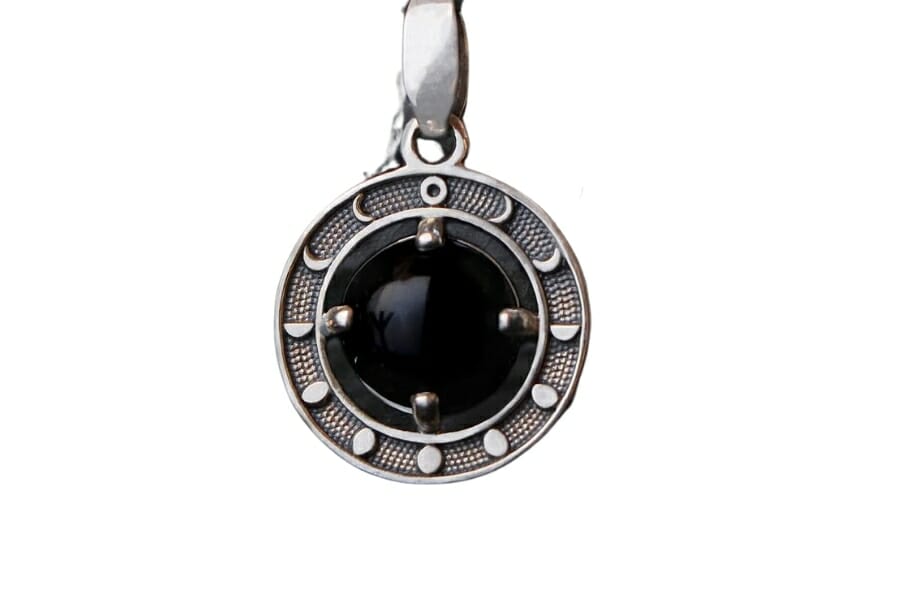
Magnetism is an interesting property that has to do with how a material responds to magnetic fields. Both obsidian and onyx are not magnetic, which they have in common.
Obsidian has no magnetic properties, so it doesn’t get pulled toward magnets in a magnetic field. Because it’s not magnetic, it works well in many situations where magnetic interference could be a problem.
Onyx is also not magnetic. They don’t have magnetic elements in them. Because of this, it can be used where magnetic interference needs to be avoided.
Both obsidian and onyx are not magnetic, which is another way they are similar. The fact that obsidian and onyx are not magnetic is a crucial part of how they can be used in different ways. They are exciting materials with their unique uses.
The Easiest Ways To Tell Obsidian and Onyx Apart
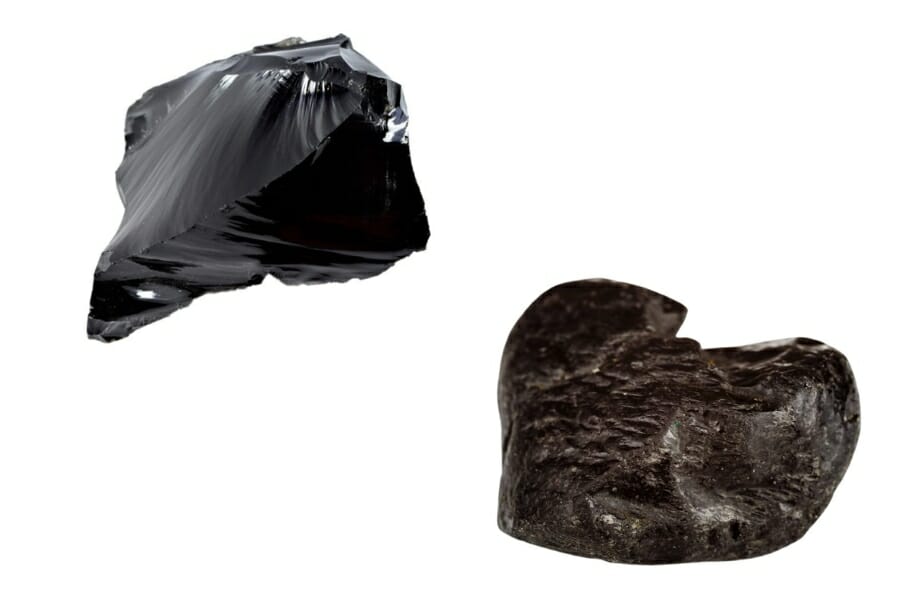
Figuring out how to tell the difference between obsidian and onyx is a fun detective game in the world of rocks. Even though they may have some things in common, a few key differences make it easy to tell them apart.
Their appearances provide a primary clue
Obsidian is a type of volcanic glass, which is usually smooth and glassy. It has a dark color and looks reflective. Most of the time, it’s black, but it can also be brown, green, or red because of impurities present when it is made.
Onyx has a striking pattern of parallel bands of different colors that alternate. The most common color combination is black and white, but brown and other colors can also be seen.
Onyx is easy to tell apart from obsidian because it has bands instead of one solid color.
Scratch them on a porcelain plate
Since obsidian doesn’t have a crystalline structure, it doesn’t have a streak. It won’t leave any colored powder behind when scratched on a porcelain plate.
Onyx has a streak that is often white. It’s different from obsidian because scratching it on a porcelain plate leaves behind a white powder.
Test it for hardness
Another way to tell onyx from obsidian is by how hard it is. Obsidian is usually between 5 and 5.5 on the Mohs scale, which means it can be scratched by things like steel or quartz, which are harder.
Onyx is usually between 6.5 and 7 on the Mohs scale, making it harder and less likely to get scratched. If you test how hard a sample is, you can tell if it’s obsidian or onyx.

